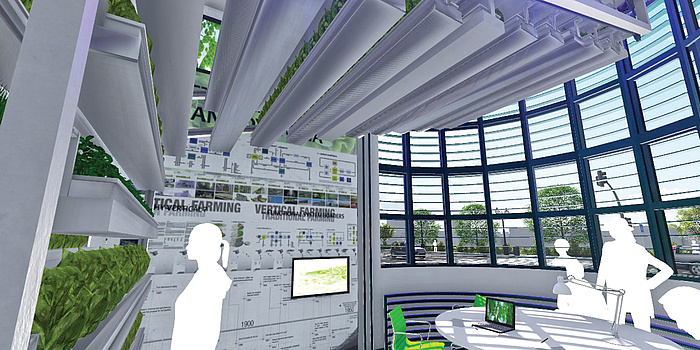The Vertical Farm Institute was founded in January 2016 by eight persons, among whom are staff of the Institute of Building and Energy at TU Graz. It serves primarily for research and networking in the vertical farming scene.
Up high
But everything in the right order. Vertical farms are greenhouses which are arranged vertically rather than horizontally. Today, classic greenhouses no longer grow their crops in soil, instead they use hydroponic systems with the plants being grown in so-called trays. The plant boxes are watered regularly with a blend of nutrients. “This also makes them very efficient regarding water consumption because the plants only absorb the water they need – the rest is recirculated,” explains Sebastian Sautter. In traditional greenhouses, the light the plants need to survive and thrive comes through a glass roof. “In vertical farming the light cannot come from above because the plants are stacked on top of each other. Light can only come into the greenhouse through the façade. This means the plants’ best exposure to light takes place directly via the façade. The idea is to transport the plants to daylight,” explains Sautter. “Plants don’t have to be exposed to light constantly. They can store light energy and you just have to supply the required daily ration of light. This makes them happy and they grow.”In the exploratory project Vertical Farming funded by the Austrian Research Promotion Agency (FFG), researchers at TU Graz’s Institute of Building and Energy, the University of Natural Resources and Life Sciences, Vienna, (BOKU Wien) and Siemens are examining current findings in vertical farming and seeing where more research should be done. The project will be phased out in March of this year. The follow-up project is already in the planning stage: a pilot experiment at the Tabakfabrik in Linz.
Lift to the light
A kind of lift system has been developed at TU Graz which transports the plants to the light. The trays are hung and slowly vertically rotated. The plants thus receive the required light in a uniform way. On top of this, they can also get artificial sunlight in the morning and evening or on bad weather days. “We’re in the optimisation phase at the moment, and we’re investigating when the best time to turn the artificial lighting on and off is. At the moment we’re planning to turn it on at 4 a.m. and turn it off at approx. 10 pm. The plants need a dark rest period for about six hours a day.” The purpose of the farms is not only to provide fruit and vegetables: optimising energy consumption is also an important topic. The trays can also serve as thermal insulation next to external walls, and are also able to use waste heat for better plant growth. They can also be positioned in areas facing south or west to provide shade and a good indoor climate. “We’ve got several ideas here, and we’re working on optimising them. Of course, it would be ideal to be involved in planning such a farm when constructing a new building. But they can also be integrated in existing buildings,” says Sautter.
Prototype for Linz
The first machine will be installed in the listed former porter’s lodge of the Tabakfabrik in Linz. “It’s not absolutely ideal because it faces north. But it’s wonderful and the windows look out onto a street – but it needs to be optimised for the users,” explains Sautter. It is intended to build the vertical farm behind the window façade and to move the trays on a slow circular path. Another arm, which extends into the room, is intended to be used for maintenance and harvesting. You can imagine it as a horizontal T. The technology group Siemens was able to be won over as a partner. Siemens wants to equip the trays with sophisticated sensors to measure the supply of water and light to optimise growth.This is how the prototype in the Tabaktrafik in Linz should work: In this YouTube-Video the people responsible are introducing their plan.
Transparency in foodstuff production
The concept has been precisely designed to achieve a rich yield of fruit and vegetables. “At the same time we also want to reduce foodstuff waste. About a third of foodstuffs are currently thrown away due to transport waste. That wouldn’t happen in our case, of course, because the head of salad which is eaten or sold would be harvested directly,” explains Sautter. Transparency in foodstuff production is also an important topic. “At the moment I cannot at all say where my fruit and vegetables come from, even when it says on the package. We want to change this using visible growing areas and thus create trust among the customers.”This research project is attributed to the Field of Expertise „Sustainable Systems“, one of TU Graz' five strategic areas of research.
Visit Planet research for more research related news.
![[Translate to Englisch:] © VFI [Translate to Englisch:] Ein simuliertes Gebäude. Zentral ist ein Raum, in dem eine Maschine steht, auf der mehrere Pflanzen zu sehen sind.](https://www.tugraz.at/fileadmin/_processed_/6/3/csm_N_S_Planetresearch_2018_VerticalFarming_Banner_by_VFI_549c879127.png)
